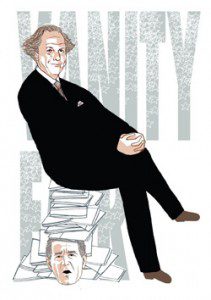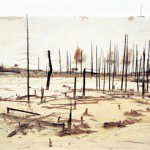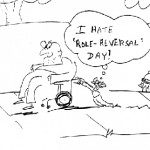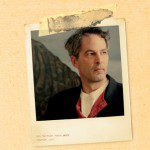Sitting Pretty
How a quintessential Canadian outsider became the ultimate American insider—and rediscovered his inner Spy
 Condé Nast is one of the world’s largest magazine publishers and its home is a 48-storey office tower in Times Square, the heart of New York City. Near the top, Graydon Carter, the Canadian-born editor of Vanity Fair – among the most successful magazines in the Condé Nast portfolio – has a bird’s eye view of America through the windows of his 22nd floor office. Or this is what his executive assistant, Jonathan, would have me believe. I made it only as far as the blanched-white lobby after sneaking up in the elevator from a few floors below. I’m unaware of it at the time, but this is the closest I will get to Graydon Carter.
Condé Nast is one of the world’s largest magazine publishers and its home is a 48-storey office tower in Times Square, the heart of New York City. Near the top, Graydon Carter, the Canadian-born editor of Vanity Fair – among the most successful magazines in the Condé Nast portfolio – has a bird’s eye view of America through the windows of his 22nd floor office. Or this is what his executive assistant, Jonathan, would have me believe. I made it only as far as the blanched-white lobby after sneaking up in the elevator from a few floors below. I’m unaware of it at the time, but this is the closest I will get to Graydon Carter.
After being passed up through layers of VF personnel, I finally speak to an enthusiastic Jonathan in early October 2006. He’s excited about my project and says an interview sounds promising. But there’s something not quite genuine about his tone. Nonetheless, I’m hopeful. I imagine myself joining Carter in his immaculate office where he leans nonchalantly against his desk. He’s wearing one of his signature bespoke suits and his undulating white hair and ironic smile emerge from a cloud of Camel Light smoke. But I never get through the door. I try again and again for five months to pin down an interview, but Jonathan won’t commit. Even my characteristic Canadian politeness won’t help me. Jonathan hands me excuse after excuse: Mr. Carter is on the West Coast, Mr. Carter is busy in meetings, Mr. Carter is travelling for most of December. I wonder how the Canadian suburbanite got so comfortable in one of the best magazine jobs in North America that he is rarely in the office. It has taken three decades and a couple of defunct magazines, but Carter is finally where he belongs. Over the past few years he has added to his resumé the titles of movie producer, author and restaurant owner. He has been able to open every door for himself, but he keeps his office door closed to me.
Today, it may seem that Carter has always belonged at VF, where he translates his love for high society, celebrity and politics into the magazine. But 14 years ago, things did not look quite as comfortable. He coasted when he first arrived, and took Fridays off. Advertisers weren’t happy. “It was a rocky early start,” says Toby Young, who joined the magazine as a contributing editor in Carter’s early days. But the new editor soon found his footing. “It was when he realized that there was a real danger that he could lose the magazine that he really knuckled down,” Young continues. “He decided to stow all that sophomoric rebelliousness and become a member of the establishment.”
But how did an outsider from suburban Ottawa manage to become the consummate insider? Is there a special view that he enjoys of America, not only from the height of his Times Square office, but also from growing up above the 49th parallel? Some observers think the outsider’s view Carter has injected into VF is largely thanks to his Canadian upbringing – and so does he. “Being Canadian helps you as a journalist in America, because you’re sort of on the outside watching this big party going on, and you’re sort of taking mental notes as it goes on,” Carter told Simon Houpt, an arts columnist in New York for The Globe and Mail, in a 2002 article. Houpt believes that Carter, “with a lifelong anglo-philia… and a hunger for stories about high society,” is right where he belongs at VF. “Carter was well positioned to perform a classically Canadian task; translating British traditions and making them palatable to Americans,” he wrote in enRoute magazine in 2003. “He turned VFinto a chronicle of the American ruling class. In time, he made friends with that ruling class and even became a member himself.”
But Carter’s curiosity seems to embrace all social levels. “He is genuinely interested in the views of the local waiter, heads of media conglomerates, and writers and artists from all areas,” says old friend Bruce Maclennan. Carter infused the pages of the magazine with this innate curiosity. Tina Brown’s VF was already a magazine of lush exteriors, with content both superficial and intellectual. Carter made this distinction even more blatant and his brand of VFhas helped boost him to aristocratic status in American journalism. He has become an honourary Hollywood celebrity – and this relationship has even given him an entree into politics. “Now that he has all these Hollywood friends, taking an interest in politics gives him something to talk about when he’s having dinner with people like Barry Diller and Fran Leibowitz and Diane von Furstenberg and Jeffrey Katzenberg,” Young says. “It makes him seem more gravitas, like he’s a major player. It undoubtedly helps further his own ambitions in Hollywood.”
Carter has become more socially and politically influential through his position at VF. His editorial page often overflows with his opinions on George W. Bush and the war in Iraq. His 2004 book, What We’ve Lost, chronicled the failings of the Bush administration. He produced two documentaries, The Kid Stays in the Picture and CBS’s award-winning film 9/11. And he recently opened a Manhattan hot spot, the Waverly Inn restaurant.
Carter has also collected an impressive number of high-profile friends. His Oscar party in West Hollywood is the place to be seen. He glides around Manhattan in a chauffeured, champagne-coloured Lincoln Navigator. He has a townhouse in the West Village and a country house in Connecticut. His ambition knows no bounds. He has come a long way from the Canadian suburbs.
Edward Graydon Carter was born on July 14, 1949 in Toronto, but spent his formative years in the middle-class suburbs of Ottawa. At 20, he headed west to work on the railroads in Saskatchewan. He showed up at the CN line near Saskatoon with long blonde hair, startlingly white teeth and bright Adidas sneakers with blue stripes. He emptied his knapsack onto his bunk, revealing books by Jack Kerouac and Richard Brautigan. The other young men in the crew had cropped haircuts and dirty work boots, and the only reading material on their bunks was girly magazines.
Back home, Carter studied politics at the University of Ottawa and Carleton University, but dreamed of moving to Manhattan. He joined the staff of a magazine called The Canadian Review, founded by a classmate. In 1975, Carter’s name appeared on the Review masthead as editor. Under his leadership, the publication grew from an eight-page pamphlet with 10 staff members to a glossy New Republic-style cultural and political magazine that employed 28 people. It lasted only three years and New Yorkmagazine reported that it left him $50,000 in debt.
Injured, but not defeated, Carter packed his bags and left Canada, leaving behind a soon-to-be ex-wife. In New York, Carter found quick success writing for Time and Life magazines. Then, in 1986, with Kurt Andersen, he co-founded Spy, his dream monthly that combined tough reporting and scathing satire. “Graydon was brilliant at pricking the pomposity of the rich and powerful; he was a thorn in the side of the media-industrial complex,” wrote Young in his memoir, How to Lose Friends and Alienate People, a biting look at his experiences working at VF. But the magazine had its share of financial problems and the creators sold Spy five years later in 1991. Carter left to become editor of The New York Observer, a newspaper he transformed into a colourful chronicle of Manhattan’s cultural obsessions.
In 1992, Condé Nast owner Si Newhouse invited Carter for a little chat. Tina Brown was leaving VF and Newhouse was making changes at The New Yorker. Carter coveted the editor’s seat there, but Newhouse had already offered the job to Brown. Instead, he accepted Brown’s old job. By the time he took the reins, the modern revival of VF was less than a decade old. The original version of the magazine first published in 1914 and achieved great popularity under editor Frank Crowninshield, who attracted the best writers of the era, including Dorothy Parker, Aldous Huxley, T.S. Eliot, Thomas Wolfe and Gertrude Stein. Within 10 years, the magazine became a bible of American establishment culture. It also became a magnet for advertisers, selling more ad pages than any other U.S. magazine. Then it began losing ground during the Great Depression, and eventually ceased publication in 1936. After a 47-year interregnum, Condé Nast relaunched the magazine. Before Brown was appointed editor in 1984, Richard Locke and Leo Lerman each briefly tried his hand at the helm. But it was under Brown, and then Carter, that the magazine regained circulation, revenue and popularity.
October 1992 was Carter’s first issue as editor, but there was not yet any hint of the changes to come. He didn’t even introduce himself to readers, choosing instead to write his editor’s letter with a voice not unlike Brown’s. It wasn’t until the following month that Carter even introduced himself. Carter brought in Christopher Hitchens as a new columnist and and introduced the VF interview – now called Q&A with George Wayne. Ad pages expanded exponentially. But there was no unique perspective in Carter’s editorials. He replaced Brown, but didn’t say anything new. VF staples, such as photos by Annie Leibovitz, Dominick Dunne’s high-society crime diary and glossy celebrity cover stories, were all part of Brown’s vision. Gradually, though, Carter brought to VF a much richer visual design, while injecting his own stylish humour and left-leaning politics.
Spy’s trademark was treating celebrities with unrestrained viciousness, but Carter’s VF became more enamoured with Hollywood stars and moguls. He created the Hollywood issue that celebrated the year’s biggest talents. It is the magazine’s thickest and richest issue every year. Since 1994, the October issue has offered the New Establishment list, a ranking of the financial world’s biggest names, often profiling those Carter once ridiculed in the pages of Spy and whom he now counts as friends. VF also offers the annual International Best-Dressed List, of which Carter belongs right at the top. And his latest creation is the Art issue, which premiered in December 2006.
In the wake of the 9/11 terrorist attacks, Carter proclaimed “the death of irony” and celebrated America with a November 2001 issue dedicated to the country’s bravery and freedom. The following issue featured Brad Pitt on the cover, proclaiming him the “All-American Heartthrob” on a red, white and blue backdrop. The issue featured special reports on United Airline’s doomed flight 93, Bin Laden’s terror operation, 9/11 cultural casualties and patriotism. In February 2002, Carter turned Bush, Vice-President Dick Cheney and other members of the administration into celebrities with an Annie Liebowitzshot cover. The tongue-in-cheek Vanities section shrunk to an average of four or five pages. “You see lots of Spy in VF,” he told the Observer. “But Spy works best when New York is really doing well, and New York is not doing very well right now.”
After the post-9/11 trauma, Carter’s true voice slowly found its way back into the magazine’s pages. Now he’s guiding VF into a new realm, Spy-ifying it with his brand of irreverence. For the past few years, the Vanities section has featured staples such as the satirical Coaster Correspondence and recent additions – such as the cheeky how-to Celebrity Step-by-Step and Morpholution, a gradual melding of famous faces. This brings to VF the same characteristics that made Spy so popular. Carter’s editorials have also become unapologetic in their criticisms of American politics. In March 2005 he wrote that the Bush administration lives “in a place where facts are passé” and says they “keep their heads high in the clouds or deep in the sand.” In 2004, according to a BuzzFlash interview, the magazine ran stories “totaling 75,000 words on the Bush agenda and the careless havoc it has wreaked worldwide.” Meanwhile, Slate touted Carter as “a radical journalist who loves nothing more than to kick off each issue with a rabble-rousing denunciation of the war in Iraq and the Bush administration.”
But Carter believes the magazine maintains a centrist line in its reporting. “We did probably 20 stories on the Clintons, and I don’t think they liked one of them,” he told BuzzFlash in the 2004 interview. “Since I have a platform, I thought I would speak my mind, because I felt very strongly about the buildup to the war. I felt that it could have ramifications not only for years, but for decades potentially.” In recent issues of VF, the politically heavy content constitutes, on average, three lengthy articles, tipping the editorial balance in a more serious direction. Contributing editors James Wolcott and Christopher Hitchens’s columns discuss the intersection between politics and culture. And in September 2006, William Langewiesche, celebrated staff writer of The Atlantic, joined VF as the magazine’s first international correspondent. Carter’s influence on the editorial pages of VF has had an impact on circulation and newsstand sales, with both reaching record levels. The second half of 2006 saw increases in subscriptions, newsstand sales (an average of 445,000 copies each month) and circulation, which is up to 1.2 million, seven per cent higher than the year before. But along with these accomplishments comes a fair share of criticism. Young says Carter’s book, What We’ve Lost, “reads like an anti-Bush primer.” American media scoff at his Hollywood ventures, saying the editor of such a celebrity-obsessed magazine should not befriend the people featured on its pages. And some reviewers call his new restaurant merely “another place for the self-important to eat $20 calamari and drink $15 Pinot Gris.” On top of all this, he still garners criticism for his climb from smart, satirical Spy to celebrity-worshipping VF. “It’s one of the ironies of Graydon’s character,” writes Young, “that if Spy were around today, he’d most certainly be included in ‘the Spy 100,’ the magazine’s annual list of ‘The Most Annoying, Alarming and Appalling People, Places and Things in New York and the Nation.'” He elaborates further on this point over the phone from England. “He’s almost like a character in a satirical comic novel about London in the 19th Century,” he says. “He starts out as this ambitious, rather idealistic young journalist. He loathes and detests the unprincipled fat cats who sit at the top of society. And then he has become one of those fat cats himself.”
Carter’s friends disagree. “I wouldn’t have thought Spy would have been a natural springboard to VF,” Maclennan says. “But it has changed with Graydon, and reflects his obsessions, irreverence, determination to dig deep on stories, and fascination with the wealthy and powerful.”
As Carter travelled from Ottawa to New York City, and up the rungs of the journalism and the American establishment ladder, VF evolved as well. In the early 1990s, he tried to please his advertisers and Condé Nast owners, but today he trusts his own instincts. He brought his outsider perspective to an insider publication, and he is now where he belongs.
It is September 2006, and I am on a tour of the New Yorker, two floors below VF. It’s the first time I feel unwanted and an overwhelming sense that I don’t belong at the “vanity” party. As my contact walks me to the elevator I think that this might be the only time I will ever step foot in the Condé Nast building. So, instead of taking the elevator down to the lobby, I push the up button.
VF’s lobby is pristine-white and its walls are lined with blown-up black-and-white images from the magazine. After I examine the photographs as if I’m at a museum, my attention is drawn to the glass doors to the left of the elevator. Through the locked glass all that I can glimpse are the giant black letters that spell out VANITY FAIR. Only a few letters are visible. The beginning of the title is around the corner where visitors like myself are not allowed. I know that somewhere beyond these doors, if I were able to follow the letters back to the V, I would find the bustling offices. And, with a view of Manhattan from his corner office, would be Graydon Carter, infusing his own vanity into the pages of VF.














